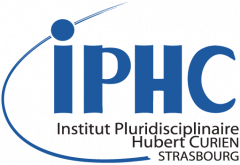Diagnostic des événements trouvés (J-10 à J+100)
Période recherchée : du 22/06/2025 au 10/10/2025
Nombre d'événements chargés : 100
European Summer School : Neutrinos Physics and Beyond the Standart Model
Speakers: Abdel-Mjid NOURREDDINE (IPHC), Lu LIU (IPHC & University of Strasbourg), Eric Baussan (IPHC / CNRS-IN2P3), Tamer Tolba (UNI/EXP (Uni Hamburg, Institut fur Experimentalphysik)) This European Summer School will be organised from 30 of June to 11 July 2025 by the Faculty of Physics and Engineering of the University of Strasbourg in collaboration with the Institute for Nuclear Waste (INE) of the Karlsruhe Institute of Technology. The school is open to young post-doctoral researchers, doctoral candidates and master's students in physics and chemistry. Registration, accommodation and meals will be free of charge. https://indico.in2p3.fr/event/35532/
Summer School on Neutrino Physics Beyond the Standard Model
Speakers: Eric Baussan (IPHC / CNRS-IN2P3), Tamer Tolba (UNI/EXP (Uni Hamburg, Institut fur Experimentalphysik)) The Summer School on Neutrino Physics Beyond the Standard Model will be organised from 29th of June to 11th July 2025 by the Faculty of Physics and Engineering of Strasbourg University - France in collaboration with Hamburg University - Germany. This year, the school will take place in the Faculty of Physics and Engineering of Strasbourg University - France. The school is open to Master's students, early and advanced doctoral candidates in physics. Registration, accommodation and lunches will be free of charge. https://indico.in2p3.fr/event/35532/
European Summer School : Radiation Measurements and Radiochemistry in Environment and Decommissioning
Speakers: Abdel-Mjid NOURREDDINE (IPHC), Lu LIU (IPHC & University of Strasbourg), Eric Baussan (IPHC / CNRS-IN2P3) This European Summer School will be organised from 1 to 5 July 2024 by the Faculty of Physics and Engineering of the University of Strasbourg in collaboration with the Institute for Nuclear Waste (INE) of the Karlsruhe Institute of Technology.The school is open to young post-doctoral researchers, doctoral candidates and master's students in physics and chemistry.Registration, accommodation and meals will be free of charge. https://indico.in2p3.fr/event/35532/
Advancing Precision: CMS Phase-2 Outer Tracker Upgrade and Innovations in Online Muon Reconstruction
Speakers: Arnab PUROHIT (IP2I) The Phase-2 upgrade of the CMS detector is a pivotal step in preparing for the high-luminosity era of the Large Hadron Collider (HL-LHC). This seminar focuses on two critical aspects of this upgrade: the Outer Tracker and the online muon reconstruction. I will discuss the ongoing Outer Tracker detector upgrade and present how machine learning techniques can enhance the performance of the muon trigger. Finally, I will conclude with a discussion on a physics analysis case focusing on Higgs to dimuon decays. https://indico.in2p3.fr/event/36629/
Nuclear fission with radioactive ion beams
Speakers: Andreï Andreyev (Univ. York) In the last two decades, through technological, experimental and theoretical advances, the situation in experimental fission studies has changed dramatically. With the use of advanced production and detection techniques much more detailed and precise information can now be obtained for the traditional regions of fission research. Crucially, new regions of nuclei have become routinely accessible for fission studies, by means of radioactive ion beams. The talk will briefly introduce classical concepts of fission, followed by examples of novel developments in fission techniques, in particular the emerging use of inverse-kinematic approaches, both at Coulomb and relativistic energies at FRS (GSI), SAMURAI (RIKEN, Japan), and VAMOS (GANIL, France) and of fission studies with radioactive beams [1]. The emphasis on the fission-fragment mass and charge distributions will be made for low-energy fission. Such studies have become possible due to the development of several complementary experimental studies, including the β-delayed fission with laser-ionized mass-separated radioactive beams at ISOLDE(CERN) [2,3]. The talk will conclude with the discussion of the new experimental fission facilities which are presently being brought into operation, along with promising 'next-generation' fission approaches, which might become available within the next decade [1]. [1] A.N. Andreyev, K. Nishio, K.-H. Schmidt, Reports on Progress in Physics, 81,1 (2018) [2] A.N. Andreyev et al, Physical Review Letters, 105, 252502 (2010) [3] A.N. Andreyev, M. Huyse, P. Van Duppen, Reviews of Modern Physics, 85, 1514 (2013) https://indico.in2p3.fr/event/36328/
CMS pixel detector operations in LHC Run 3
Speakers: Grace Haza (University of Nebraska Lincoln) The pixel tracker is the innermost component of the silicon tracking system of the CMS experiment. It was refurbished with a complete replacement of the innermost layer of the barrel section during a Long Shutdown period of the Large Hadron Collider (LHC). It was re-installed in the CMS experiment and has provided high-quality physics data during LHC Run 3, which began in 2022 and will end in 2026. The performance is evolving with radiation damage. This talk will summarize recent performance results and operational challenges. https://indico.in2p3.fr/event/36642/
Electroweak corrections on tau production
Speakers: Jose Luis Hernando (Uni Freiburg) https://indico.in2p3.fr/event/36471/
Theoretical predictions for tau-pair production in ultraperipheral hadron collisions
Speakers: Jose Luis Hernando Ariza (Freiburg University) The anomalous magnetic moments of the electron and the muon have been measured with remarkable precision. On the other hand, there is no precise measurement for the magnetic moment of the tau-lepton. A promising approach is to measure it via the tau-pair production in ultraperipheral collisions of lead ions at the LHC. In this talk, I will present state-of-the-art theoretical predictions for photonic tau-pair production assuming leptonic tau-decays. In particular, the impact of spin correlations between the tau-leptons and next-to-leading-order electroweak corrections will be discussed. https://indico.in2p3.fr/event/36471/
École de GIF 2025 : les futurs collisionneurs et leur physique
les futurs collisionneurs et leur physique https://indico.in2p3.fr/event/36304/
